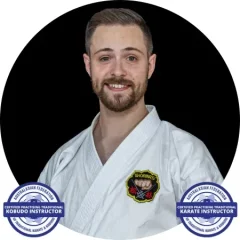-
Posts
116 -
Joined
-
Last visited
Personal Information
-
Martial Art(s)
Matsubayashiryu Karatedo Kobujutsu, Yamaneryu Kobudo
-
Location
Australia
-
Occupation
Head Instructor (Kancho) at the Kodokan Cummings Karate Dojo
President, Australasian Federation of Traditional Karate and Kobudo (AFTK) - Website
Recent Profile Visitors
RJCKarate's Achievements

Orange Belt (3/10)
-

Extensive Testing
RJCKarate replied to Nidan Melbourne's topic in Share Your Testing, Grading, or Promotion
This is a very interesting grading format, and I can see how it could work for clubs who come together. Personally, I would hope that people don't become candidates if their attitude is unacceptable and has been screened beforehand. I wouldn't expect many candidates to be failing on that portion... although I've had a circumstance where I've observed a candidate behave in a way that wouldn't generally be acceptable, but the reason may have been permissible. How did you find evaluating grades that are much senior to your own? That's also a big grading... I don't know many clubs in Australia that would have such a number of senior grades. -

What to do about students (kids) that don't want to train?
RJCKarate replied to DWx's topic in Instructors and School Owners
I'll have a chat to them, then their parent. If they're simply no longer interested, I usually recommend a break. -

Shorin-Ryu and its similarities/differences to Wado-Ryu and Shito-Ryu
RJCKarate replied to Nidan Melbourne's topic in Karate
Actually, I believe there's one under Onaga Yusuke. But neither Shitoryu or Wadoryu are considered Okinawan karate. -

Shorin-Ryu and its similarities/differences to Wado-Ryu and Shito-Ryu
RJCKarate replied to Nidan Melbourne's topic in Karate
Both have a strong foundation in Shorinryu (more Chibana than Kyan), but life any style, there are subtle differences that really define the stylistic lenses. As the parent style, perhaps they somewhat have the ability to look at their grand/children and day, 'hey, I'm happy with that'. For example, I tell my students up until 4Kyu we're rally just learning Karate. From 3Kyu it should be obvious of the differences between Shorinryu and other styles, and from 1Dan it should be clear they do Matsubayashiryu not Sho/Kobayashiryu. Just my thoughts! -
My group, of which I'm in, is from 13:30!
-

How important is time in rank?
RJCKarate replied to Luther unleashed's topic in Instructors and School Owners
The class requirement scales up for each grade. 0?8Kyu 20 classes, 2>1Kyu 48. We have a minimum attendance policy of attending twice per week, so it's really based around this. 40 classes would be at least two terms, which is on average, how people progress. -
I don't refer to myself as sensei, and, I use 'Kancho' when it comes to any reference needed. Some interpret this as being grandiose, but it's the opposite. This is my position, and others choose whether to call me sensei. However, I maintain a student-teacher relationship with all my students, and while I have strong friendships, I don't create friends at the dojo. This is how I was taught, and it's how I find it best to operate (and I do the same as an educator). I would expect that my students attach an appropriate honorific in all our correspondence, because to me, Karate isn't an activity, it's a way of life. If they don't identify with that, I've no issue. There are many dojo.
-
RJCKarate changed their profile photo
-

How important is time in rank?
RJCKarate replied to Luther unleashed's topic in Instructors and School Owners
I have a classes policy rather than time, as I believe hours training is more important than time in grade. It also accounts for individuals learning differently. The requirement is quite minimal. Most take around 5-8 years to become Yudansha. For BmYudansha there is the nominal years (eg 2>3Dan 3 years) as well as the classes. -
RJCKarate started following Is it normal ? , Member of the Month for March 2024: RJCKarate , Coaching Accreditation in your Country and 6 others
-

Member of the Month for March 2024: RJCKarate
RJCKarate replied to Patrick's topic in KarateForums.com Announcements
Cheers all! Whilst many new ways to engage have developed over the last 18 years, I still very much enjoy the forum format, and I read the topics here regularly. -

Coaching Accreditation in your Country
RJCKarate replied to Nidan Melbourne's topic in Instructors and School Owners
I recognise the AFK provides sports coaching accreditation, but Australia has a variety of ways to get accredited as a coach, but the word "accredited" is the difficult bit. The AFTK, a body for traditional karate and kobudo, also provides a certification process recognised by various bodies throughout Australia: https://aftk.org.au/membership/certification/ -

Do you proudly display your Dan rank within your household?
RJCKarate replied to Journyman74's topic in Karate
I have a range of qualifications up in my home office - Martial arts, academic, professional. I enjoy having the visual reminder of the work they've taken, despite there always being more to learn. -
I personally don't think there is a lack of interest, and in fact, I think we are seeing a rise in adults wanting to practice traditional martial arts for both their physical and mental benefits. What I am seeing though, is more mainstream sports and BJJ/MMA schools putting time and effort into creating professional studios with consistent marketing. This is something traditional schools aren't doing, and in today's age, being a 'good school, good style, good teacher' is simply not enough and it is something new students don't appreciate as they don't understand the value of it yet, either.
-

teaching for free(almost)
RJCKarate replied to Spartacus Maximus's topic in Instructors and School Owners
I always find this topic to be interesting. I operate a not-for-profit club which means that surplus made goes back into the dojo - we use it to run community events, purchase equipment, and essentially run a 'full time' dojo similar to any other commercial facility, except, our focus is community and no profits can be drawn from the funds. However, a few years ago we made the decision -- on the basis we wanted to be professional and align with how many other NFPs run -- to employ paid instructors. This meant that it rewarded them for their dedication, added responsibility that was needed to ensure we have consistency for our students, and also actually met expectations of our students (they thought people were paid) - especially me as the head instructor. I teach 15 hours a week and spend at least 10 hours a week on admin and did this while maintaining a FT job for a long time. Now, I still maintain my FT job (which is a different business I own) but with being a paid instructor, this gives me added time to give to the dojo, and ultimately benefits them. This has allowed us to grow into a fully-dedicated and purposely designed facility, meaning that we can do what we want, when we want, how we want. It gives us capacity to also preserve the cultural heritage and education my teachers have handed down. We do month-to-month fees (and we're very low - around 50% of our competitors), and no contracts. I know it's not exactly what you asked, however, I feel passionate about the martial arts and often think as instructors we undervalue ourselves, and ultimately undervalue the impact of the industry we're in. Best for the future. -

What is your best tip to bring in adult students
RJCKarate replied to kenpo4life's topic in Instructors and School Owners
I have a strong focus on adults karate and kobudo in my dojo and have around 100 adult karate students, and 30 kobudo students. I believe we've successfully hosted a strong adults roster because: 1. We focus on karate for self defence. 2. 60% of our training is partnerwork. 40% is kata, kihon, etc. 3. We give the opportunity for students to train with varying levels of contact and intensity. 4. Our instructors are taught to teach and to understand andragogy and that instructors facilitate learning while students are required to take responsibility for their own learning. 5. We have a variety of online learning resources to support them. 6. They don't train with young kids, and there are many adults to train with. 7. We run a lot of community engagement and social activities and focus on creating a sense of belonging. 8. We have a strong marketing plan in place (this is my professional day job) and our material is marketed to adults. Hope this helps!





